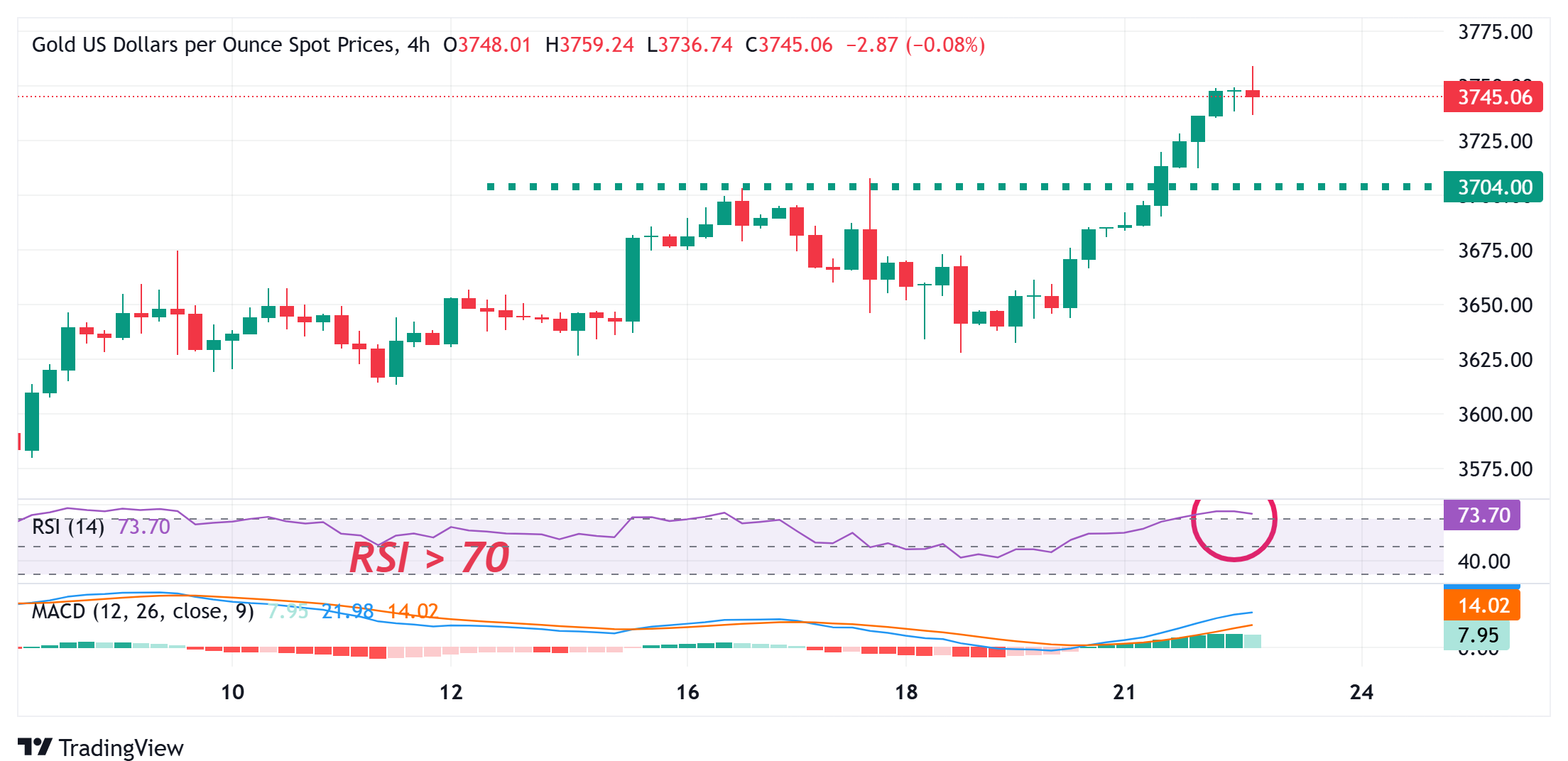Gold eases after hitting fresh all-time high on dovish Fed and geopolitical tensions
- Gold draws support from a combination of factors and touches a fresh all-time high on Tuesday.
- The Fed’s dovish outlook capped the recent USD recovery and offers support to the commodity.
- Rising geopolitical tensions turn out to be another factor underpinning the safe-haven XAU/USD.
Gold (XAU/USD) retreats slightly after touching a fresh all-time peak, in the $3,759-3,760 zone during the Asian session on Tuesday, as bulls turn cautious amid extremely overbought conditions. Furthermore, a generally positive tone around the equity markets turns out to be another factor acting as a headwind for the safe-haven commodity. However, any meaningful corrective decline still seems elusive in the wake of dovish Federal Reserve (Fed) expectations, which might continue to offer support to the non-yielding yellow metal.
In fact, the US central bank lowered borrowing costs last Wednesday for the first time since December and signaled that two rate cuts would follow through this year amid signs of a softening labor market. This, in turn, keeps the US Dollar (USD) depressed below a one-week high, touched on Monday, and should offer some support to the Gold. Moreover, geopolitical risks stemming from the Russia-Ukraine war and conflicts in the Middle East should limit losses for the commodity ahead of Fed Chair Jerome Powell's speech later today.
Daily Digest Market Movers: Gold bulls retain control amid dovish Fed expectations, geopolitical risks
- Firming expectations of further interest rate cuts by the US Federal Reserve and persistent safe-haven demand, fueled by rising geopolitical tensions, lifted the Gold price to a fresh all-time peak during the Asian session on Tuesday.
- Fed Chair Jerome Powell said last Wednesday that the move to lower interest rates was a risk management cut and added that he doesn't feel the need to move quickly on rates as risks to inflation remain tilted to the upside.
- Traders, however, believe that interest rates will drop much faster than the Fed is projecting and are betting on the possibility that the short-term rate, currently in the 4.00%-4.25% range, will fall under 3% by the end of 2026.
- This, in turn, led to the overnight pullback in the US Dollar (USD) from an over one-week high, which, along with safe-haven demand fueled by rising geopolitical tensions, might continue to underpin the safe-haven commodity.
- Despite recent diplomatic efforts to find ways to end the more than three-year war, fighting has intensified in recent months. In fact, Russia and Ukraine accused each other of deadly drone strikes on civilian areas on Monday.
- Meanwhile, NATO countries have accused Russia of violating the airspace of alliance members Estonia, Poland, and Romania. Russia, however, rejected the claims and blamed the European powers for levying baseless accusations.
- Hamas escalated its attacks and launched multiple rockets on Israel amid the intensifying attacks by the Israeli Defense Forces in Gaza. Meanwhile, the Trump administration has cautioned Israel against annexing the West Bank.
- Traders now look forward to Fed Chair Jerome Powell's scheduled speech later during the North American session, which might influence the USD price dynamics and provide short-term impetuses to the XAU/USD pair.
Gold bulls seem unaffected by overbought daily RSI; dip-buying should limit corrective pullbacks

From a technical perspective, the overnight breakout and close above the $3,700 mark could be seen as a fresh trigger for bullish traders. Moreover, the recent move up remains unaffected by the overbought Relative Strength Index (RSI) on the daily chart. This, in turn, backs the case for a further near-term appreciating move for the Gold price, suggesting that any corrective slide could be seen as a buying opportunity.
Meanwhile, the $3,726-3,725 region now seems to protect the immediate downside ahead of the $3,700 round figure. The next relevant support is pegged near the $3,686-3,685 zone, which, if broken, might prompt some technical selling and drag the Gold price to the $3,651-3,650 area. A convincing break below the latter would point to a possible bullish exhaustion and pave the way for a deeper corrective decline.
Fed FAQs
Monetary policy in the US is shaped by the Federal Reserve (Fed). The Fed has two mandates: to achieve price stability and foster full employment. Its primary tool to achieve these goals is by adjusting interest rates. When prices are rising too quickly and inflation is above the Fed’s 2% target, it raises interest rates, increasing borrowing costs throughout the economy. This results in a stronger US Dollar (USD) as it makes the US a more attractive place for international investors to park their money. When inflation falls below 2% or the Unemployment Rate is too high, the Fed may lower interest rates to encourage borrowing, which weighs on the Greenback.
The Federal Reserve (Fed) holds eight policy meetings a year, where the Federal Open Market Committee (FOMC) assesses economic conditions and makes monetary policy decisions. The FOMC is attended by twelve Fed officials – the seven members of the Board of Governors, the president of the Federal Reserve Bank of New York, and four of the remaining eleven regional Reserve Bank presidents, who serve one-year terms on a rotating basis.
In extreme situations, the Federal Reserve may resort to a policy named Quantitative Easing (QE). QE is the process by which the Fed substantially increases the flow of credit in a stuck financial system. It is a non-standard policy measure used during crises or when inflation is extremely low. It was the Fed’s weapon of choice during the Great Financial Crisis in 2008. It involves the Fed printing more Dollars and using them to buy high grade bonds from financial institutions. QE usually weakens the US Dollar.
Quantitative tightening (QT) is the reverse process of QE, whereby the Federal Reserve stops buying bonds from financial institutions and does not reinvest the principal from the bonds it holds maturing, to purchase new bonds. It is usually positive for the value of the US Dollar.

